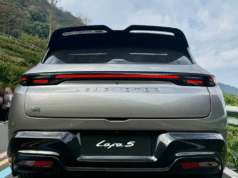
The global automotive industry is undergoing the most profound transformation in its 140-year history. What began as a gradual shift toward cleaner transportation has now become a geopolitical, economic and technological race that is reshaping global markets, trade balances and industrial strategies, News.az reports.
Electric vehicles (EVs) and advanced battery technologies are no longer niche alternatives – they are the core drivers of the next industrial revolution, influencing everything from mineral supply chains and energy markets to national security policies and global alliances.
Over the past decade, EV adoption has accelerated at an unprecedented pace. According to international energy forecasts, electric vehicles could account for more than half of all new car sales by 2035. This explosive growth is fueled by several factors: stricter emission standards, climate commitments, lower production costs and breakthrough innovations that have dramatically extended driving range. However, behind this surge lies an equally significant story – the battery revolution, which dictates the pace of the entire EV ecosystem.
At the center of this transformation is the global competition for dominance in battery manufacturing. Lithium-ion batteries, once considered an expensive luxury used only in electronics, have become the heart of modern mobility. The world’s largest economies have recognized that controlling battery production is synonymous with controlling the future of the car industry. China currently leads the field, producing more than 70 percent of global EV batteries, thanks to early investments, massive state support and control over critical mineral supply chains in Africa, Latin America and Central Asia. Chinese companies such as CATL and BYD have gained technological advantages that allow them to produce high-efficiency batteries at lower costs, reshaping the competitive landscape for American, European and Japanese manufacturers.
This dominance has triggered strategic responses across the world. The United States, through the Inflation Reduction Act, is investing billions to stimulate domestic battery and EV production, reduce dependence on Chinese supply chains and attract global manufacturers. Europe, meanwhile, is scrambling to build its own Gigafactories, fearing that a failure to catch up could make the continent permanently dependent on imports for both batteries and vehicles. The European Union’s push to phase out internal combustion engines by 2035 has forced automakers to rethink long-term strategies, invest in new technologies and forge alliances with battery manufacturers from Asia to North America.
Battery chemistry itself is undergoing a technological revolution. Solid-state batteries, which promise faster charging times, longer range and improved safety, are widely seen as the next big leap. Several companies, including major Japanese and American manufacturers, are preparing commercial launches within the next five years. If successful, solid-state technology could be a turning point, positioning early adopters at the forefront of the industry and accelerating global EV adoption.
However, the rise of EVs has exposed a critical geopolitical vulnerability: mineral supply chains. Key battery materials such as lithium, nickel, cobalt and manganese are concentrated in a handful of countries, creating new dependencies and competition. Latin America’s Lithium Triangle – consisting of Chile, Argentina and Bolivia – controls more than half of the world’s lithium reserves. Indonesia has become a major player in nickel production, while the Democratic Republic of the Congo remains the dominant source of cobalt. This concentration has forced global powers to redesign their diplomatic and economic strategies, seeking long-term partnerships to secure stable access to minerals.
Countries like Azerbaijan, Kazakhstan and Türkiye are emerging as important actors in the mineral and logistics chain. Azerbaijan’s growing interest in critical minerals and its role as a transport hub on the Middle Corridor offer new opportunities for connecting Central Asian resources to global markets. Kazakhstan’s vast mineral base and partnerships with Western and Asian companies further strengthen regional importance. These developments show that EV-related supply chains are not only technological but also geopolitical, changing the role of countries traditionally outside the automotive spotlight.
Beyond cars, battery technologies are transforming global energy markets. Improved battery storage enables more reliable integration of wind and solar power into national grids, reducing dependence on fossil fuels and enhancing energy security. Gulf countries such as Saudi Arabia and the UAE are investing heavily in battery storage projects to support large-scale renewable energy production. China and the United States are competing to develop next-generation grid storage technologies, viewing them as essential to future national power systems.
In the consumer market, EV affordability is becoming a decisive factor. China’s low-cost EV boom – particularly the emergence of compact city models – has disrupted global pricing structures and placed pressure on Western manufacturers to innovate faster and reduce costs. The United States and Europe are responding with new tariffs, incentives for domestic production and attempts to attract Asian battery producers to build factories locally. This competition is reshaping global trade rules and industrial policies, sometimes creating tensions between major economies.
Meanwhile, automakers are integrating artificial intelligence, autonomous driving systems and new digital services into EV platforms, turning cars into connected devices and expanding revenue models. Software-defined vehicles – where updates and features are delivered digitally – are expected to create a new era of competition, where tech companies and automakers converge.
The transformation driven by electric vehicles and battery technologies is more than an industrial shift – it is a redefinition of global power dynamics. The countries that secure mineral resources, master battery innovation, build resilient supply chains and invest in clean energy infrastructure will set the pace of the twenty-first-century economy. As this technological race accelerates, middle powers, emerging economies and resource-rich states are all finding new roles within the evolving geopolitical map. The future of mobility is electric, and the forces shaping it are already rewriting the rules of global markets.









